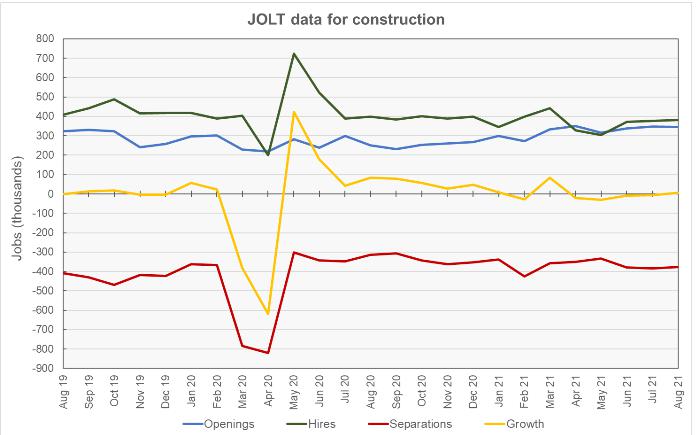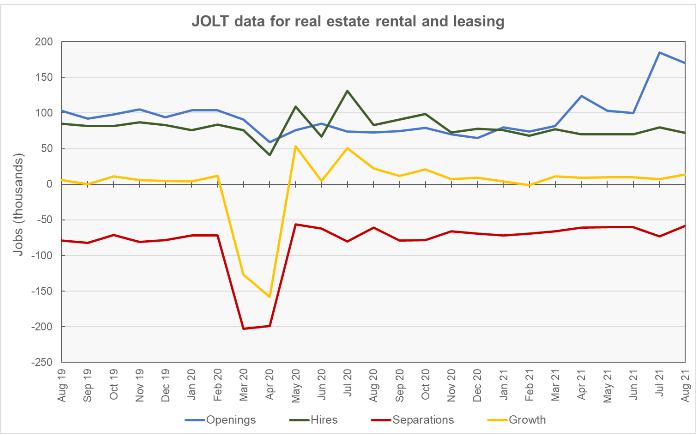The Bureau of Labor Statistics (BLS) recently released the Job Openings and Labor Turnover (JOLT) report for August. It reported that the number of job openings fell slightly but remained at a high level.
Evaluating the overall jobs market
For a discussion of the JOLT report and how it relates to the Employment Situation Report, please see the paragraph at the end of this article.
The BLS reported that there were 10.4 million job openings at the end of August. This represents 6.6 percent of the total employment plus job openings. For comparison, the BLS earlier reported that the unemployment rate in September was 4.8 percent and 7.7 million people were unemployed.
Within the nonfarm labor market, the number of people hired for a new job was 6.3 million while the number of people leaving their old jobs was 6.0 million. Of those leaving their jobs, 4.3 million left voluntarily, while 1.3 million people were involuntarily separated from their jobs. The remainder of people leaving their jobs left for other reasons, such as retirements or transfers. The portion of people quitting their jobs was 2.9 percent, the highest rate that the BLS has seen since they have been tracking this data.
Construction employment rises slightly
The first chart, below, shows the employment situation for the construction jobs market over the last 25 months. It shows that the construction jobs market eked out a small increase in employment in August after suffering a net loss in employment in each of the 4 prior months.

Revisions to July’s data were nearly balanced with the number of hires adjusted downward by 7,000 and the number of separations adjusted downward by 8,000, resulting in a minimal change in the job losses reported for the month.
In August, openings for construction jobs were reported to fall 0.9 percent (-3,000 openings) month-over-month, but only because July’s figure was revised sharply upward by 26,000 openings. Construction jobs openings in August were reported to be 344,000 jobs.
Hiring was reported to be up 4,000 jobs in August, but hiring was only higher because of the downward revision in the hiring figure from the month before. The reported increase in hiring for construction jobs was 4,000 jobs, or 1 percent of employment, at 381,000 jobs.
Construction jobs separations were reported to fall 7,000 jobs, or 1.8 percent, in August to 376,000 jobs. Quits were effectively unchanged at 199,000 jobs while layoffs fell by 5.8 percent from July’s revised figure (10,000 jobs) to 159,000 jobs. “Other separations” which includes retirements and transfers, were reported to be unchanged from July’s revised figure (+3,000 jobs) at 18,000 jobs. Quits represented 58 percent of separations for the month.
RERL jobs growth stays positive
The last chart, below, shows the employment situation for the real estate and rental and leasing (RERL) jobs category. Employment growth in this jobs category has been positive every month since May 2020 with the exception of February 2021 when 1,000 jobs were reported to be lost.

The number of job openings in the RERL category remained elevated in August at 170,000 jobs. This was down 8 percent for the month (-15,000 jobs), but was still up 53 percent compared to the trailing 6-month average.
Hiring in August was down 10 percent from July’s revised (+4,000) figure to 72,000 jobs.
Separations in August were down 20 percent from July’s revised figure (+8,000 jobs) to 58,000 jobs. Quits were down 42 percent to 31,000. Quits represented 64 percent of total separations in August.
The numbers given in the JOLT report are seasonally adjusted and are subject to revision. It is common for small adjustments to be made in subsequent reports, particularly to the data for the most recent month. The full current JOLT report can be found here.
The reports
The US labor market is very dynamic with many people changing jobs in any given month. The JOLT report documents this dynamism by providing details about job openings, hiring and separations. However, it does not break down the jobs market into as fine categories as does the Employment Situation Report, which provides data on total employment and unemployment. For example, while the Employment Situation Report separates residential construction from other construction employment, the JOLT report does not. The Employment Situation Report separates residential property managers from other types of real estate and rental and leasing professionals, but the JOLT report does not. However, the JOLT report provides a look at what is driving the employment gains (or losses) in broad employment categories.













